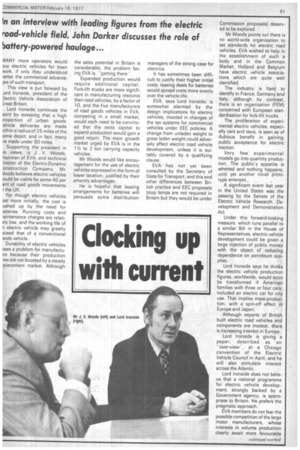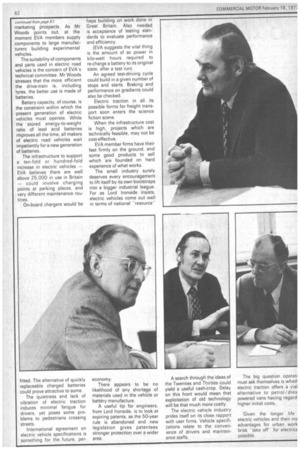In an interview with leading figures from the electric road-vehicle field, John Darker discusses the role of battery-powered haulage...
Page 63

Page 64

If you've noticed an error in this article please click here to report it so we can fix it.
VlANY more operators would )uy electric vehicles for town work, if only they understood )etter the commercial advantajes of such transport.
This view is put forward by .ord lronside, president of the Electric Vehicle Association of 3reat Britain.
Lord Ironside continues the )oint by stressing that a high iroportion of urban goods deliveries are made vithin a radius of 25 miles of the iome depot, and in fact, many re made under 50 miles.
Supporting the president in is views, is J. V. Woods, hairman of EVA, and technical irector of the Electra-Dynamic :onstruction Company. Mr Voods believes electric vehicles rould be viable for some 40 per ent of road goods movements )the UK.
For though electric vehicles ast more initially, the cost is ushed up by the need for atteries. Running costs and laintenance charges are relatiely low, and the working life of n electric vehicle may greatly Kceed that of a conventional oods vehicle.
Durability of electric vehicles oses a problem for manufactuirs because their production les are not boosted by a steady iplacement market. Although
the sales potential in Britain is considerable, the problem facing EVA is, -getting there".
Expanded production would require additional capital. Fork-lift trucks are more significant in manufacturing resource than road vehicles, by a factor of 10, and the five manufacturers of road goods vehicles in EVA, competing in a small market, would each need to be convinced that the extra capital to expand production would gain a good return. The main growth market urged by EVA is in the 11/2 to 2 ton carrying capacity vehicles.
Mr Woods would like encouragement for the use of electric vehicles expressed in the form of lower taxation, justified by their amenity advantages.
He is hopeful that leasing arrangements for batteries will persuade some distribution managers of the strong case for electrics.
It has sometimes been difficult to justify their higher initial costs; leasing deals for batteries would spread costs more evenly over the vehicle life.
EVA, says Lord Ironside, is somewhat alarmed by the design implications for electric vehicles, mooted in changes of the tax systems for commercial vehicles under EEC policies. A change from unladen weight to gross laden weight could adversely affect electric road vehicle development, unless it is suitably covered by a qualifying clause.
EVA has not yet been consulted by the Secretary of State for Transport, and this and other differences between British practice and EEC proposals (stop lamps are not required in Britain but they would be under Commission proposals) deserved to be explored.
Mr Woods points out there is no world-wide organisation to set standards for electric road vehicles. EVA wished to help in the establishment of such a body and in the Common Market, Holland and Belgium have electric vehicle associations which are quite well identified.
The industry is hard to identify in France, Germany and Italy, although by contrast, there is an organisation (FEM) concerned with European standardisation for fork-lift trucks.
The proliferation of experimental electric vehicles, especially cars and taxis, is seen as of dubious benefit in gaining public acceptance for electric traction.
Very few experimental models go into quantity production. The public's appetite is whetted and nothing happens, until yet another novel proto type emerges._ .
A significant event last year in the United States was the passing by the Senate of the Electric Vehicle Research, Development and Demonstration Act.
Under this forward-looking measure, which runs parallel to a similar Bill in the House of Representatives, electric vehicle development could be given a large injection of public money with the object of reducing dependence on petroleum supplies.
Lord Ironside says he thinks the electric vehicle production figures, worldwide, would soon be transformed if American families with three or four cars, included an electric car for city use. That implies mass-production, with a spin-off effect in Europe and Japan.
Although exports of British built electric road vehicles and components are modest, there is increasing interest in Europe.
Lord Ironside is giving a paper, described as an "over-view-, at a Chicago convention of the Electric Vehicle Council in April, and he will also stimulate interest across the Atlantic.
Lord Ironside does not believe that a national programme for electric vehicle development, strongly backed by a Government agency, is appropriate to Britain. He prefers the pragmatic approach.
EVA members do not fear the possible competition of the large motor manufacturers, whose interests in volume production clearly await more favourable marketing prospects. As Mr Woods points out, at the moment EVA members supply components to large manufacturers building experimental vehicles.
The suitability of components and parts used in electric road vehicles is the concern of EVA's technical committee. Mr Woods stresses that the more efficient the drive-train is, including tyres, the better use is made of batteries.
Battery capacity, of course, is the constraint within which the present generation of electric vehicles must operate_ While the stored energy-to-weight ratio of lead acid batteries improves all the time, all makers of electric road vehicles wait impatiently for a new generation of batteries.
The infrastructure to support a ten-fold or hundred-fold increase in electric vehicles -- EVA believes there are well above 25,000 in use in Britain — could involve charging points at parking places, and very different maintenance routines_ On-board chargers would be fitted. The alternative of quickly replaceable charged batteries could prove attractive to some.
The quietness and lack of vibration of electric traction induces minimal fatigue for drivers, yet poses some problems to pedestrians crossing streets.
International agreement on electric vehicle specifications is something for the future, per haps building on work done in Great Britain. Also needed is acceptance of testing standards to evaluate performance and efficiency.
(EVA suggests the vital thing is the amount of ac power in kilo-watt hours required to re-charge a battery to its original state, after a test run).
An agreed test-driving cycle could build in a given number of stops and starts. Braking and performance on gradients could also be checked.
Electric traction in all its possible forms for freight transport soon enters the science fiction scene.
When the infrastructure cost is high, projects which are technically feasible, may not be cost-effective.
EVA member firms have their feet firmly on the ground, and some good products to sell which are founded on hard experience of what works The small industry surely deserves every encouragement to lift itself by its own bootstraps into a bigger industrial league. For as Lord lronside insists, electric vehicles come out well in terms of national "resource" economy.
There appears to be no likelihood of any shortage of materials used in the vehicle or battery manufacture.
A useful tip for engineers, from Lord lronside, is to look at expiring patents, as the 50-year rule is abandoned and new legislation gives patentees stronger protection over a wider area. A search through the ideas of the Twenties and Thirties could yield a useful cash-crop. Delay on this front would mean that exploitation of old technology will be that much more costly.
The electric vehicle industry prides itself on its close rapport with user firms. Vehicle specifications relate to the convenience of drivers and maintenance staffs. The big question operat( must ask themselves is whet electric traction offers a vial alternative to petrol /dies powered vans having regard higher initial costs.
Given the longer life electric vehicles and their ma advantages for urban work brisk "take off" for electrics possible.








































































































